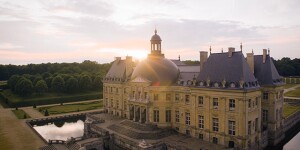D efining the Bloomsbury group is like trying to grab hold of a cloud. Its content is hazy, its beginnings and ends blurred. It was never an official group; people came and went, fell in, fell out. Yet, this indistinct set of cultural figures from the early 1900s through the late-1930s – including the writers Virginia Woolf and EM Forster, economist John Maynard Keynes and painters Vanessa Bell, Duncan Grant and Dora Carrington – has become synonymous with a certain free-spirited modernism. One, at the time, distinctly un-British in nature.
Splitting their time between London – in the Bloomsbury townhouses from which they acquired their name – and quiet country retreats, particularly Charleston (a 17th-century farmhouse in East Sussex that became the home of Keynes, Bell and Grant) this gaggle of friends, lovers and relatives – sometimes all three at once – painted, wrote, debated and vigorously romanced.
Radical Modernity: From Bloomsbury to Charleston | A Sotheby's Collaboration
This autumn, Sotheby’s stages Radical Modernity: From Bloomsbury to Charleston, a landmark private selling and loan exhibition in collaboration with Charleston, curated by the fashion designer Kim Jones, a long-time admirer of the group’s aesthetic. “I first went to Charleston when I was around 14, to go sketching in the garden, and I still have the brochure from that day,” he recalls in an interview with Sotheby’s Magazine. In the spring of 2024, Jones, the artistic director for Dior Men, was appointed vice president of the museum that had enthralled him as a boy.
Vanessa Bell’s paintings have been the focus of two dedicated exhibitions this year. Vanessa Bell: A Pioneer of Modern Art at the Courtauld Gallery in London, from May to October, and currently the largest ever solo exhibition of her work is available to view at MK Gallery in Milton Keynes, Vanessa Bell: A World of Form and Colour, until 23 February 2025. An exciting reappraisal of Dora Carrington’s work will also be staged at Pallant House in Chichester, Dora Carrington: Beyond Bloomsbury (until 27 April 2025). This will be the first museum exhibition of works by Carrington in almost 30 years.
Sotheby’s expansive survey of pictures, clothes, ceramics, furniture and manuscripts from Charleston and other collections, further highlights the ardent interest these Edwardian and interwar mavericks continue to hold on the public imagination.
Living Like a Bloomsbury
“I think the enduring fascination with the group is more of a ‘lifestyle’ phenomenon,” observes the British author, William Boyd. In his 2020 novel Trio, Boyd follows the attempts of a writer to reimagine the last day of Virginia Woolf’s life. The group’s lifestyle was a curious concoction: the ingredients of town and country and myriad artistic mediums, stirred by cooks with spicy imaginations, created a look that many have tried to unpick.
“Did Bloomsbury have a ‘look’? Absolutely. What was it? That’s more difficult to pin down,” writes Wendy Hitchmough, a former curator at Charleston and author of The Bloomsbury Look. Their “dress code signified an alternative mind-set, a freedom to explore radical ideas in an environment that challenged and subverted conventions.” This resulted in red-and-gold crocheted caps for men, while “corsets were abandoned and Vanessa Bell made vibrant, loose-fitting dresses that expressed her modernity.”
This theatricality extended to their homes. “Charleston is to British art what Monet’s Garden at Giverny is for Impressionism,” observes Bryn Sayles, Head of Sale, Modern British & Irish Art at Sotheby’s, touching on another attraction: never underestimate the appeal of colorful types gossiping on lawns.
A Venn Diagram of Eroticism
The prickly-eyed American wit Dorothy Parker – whose own bohemian set, the Algonquin Round Table, were simultaneously disrupting things over in New York – famously quipped that the Bloomsbury group “lived in squares, painted in circles and loved in triangles.”
This erotic geometry continues to fascinate. The “Bloomsberries” practically redefined the definition of a complicated love life. “Everything is at sixes and sevens,” wrote Lytton Strachey, the critic and biographer who adored the painter Dora Carrington yet pursued her husband, the resolutely straight Ralph Partridge. “Ladies in love with buggers and buggers in love with womanisers, and the price of coal going up too. Where will it all end?”
In fact, that sexual mutability – the forceful avoidance of properness – is one of the aspects that resonates with a contemporary audience. As is their emphasis on talented and trail-blazing women.
On the Page and On the Screen
The group has not always been in vogue, however. “The Bloomsbury ‘boom’ began, I believe, with the publication of Michael Holroyd’s two-volume life of Lytton Strachey in 1967 and ’68,” notes William Boyd. “Nobody really gave much thought to the Bloomsbury Group before then – curios in a side-show of English literary life. Even Virginia Woolf had no great literary reputation in the 1960s, either, being patronized as a ‘woman’s writer’ by critics. The Strachey biography and, in 1972, Quentin Bell’s two-volume biography of Virginia Woolf (his aunt) changed everything. Suddenly the Bloomsbury group had arrived.” Woolf’s diaries (all five volumes) were published later in the 1970s. Bloomsbury-related books have appeared regularly ever since.
And, of course, all the biographical drama – infidelities, wartime calamities, creative crises and tragic suicides – has been catnip to filmmakers. In 2002, Nicole Kidman won a Best Actress Oscar for her depiction of Virginia Woolf in The Hours, an adaptation of Michael Cunningham’s Pulitzer Prize-winning novel. Seven years earlier, Emma Thompson’s turn as Dora Carrington, who shot herself following the death of Lytton Strachey, also won plaudits. The British film critic David Thomson observed that Carrington (1995) was “the best film about this moment and group in great part because it has the sense to concentrate on a fringe figure.” In its way, the Bloomsbury group was a company of character actors.
The group itself loved the lens. In her new book The Bloomsbury Photographs (Yale, 2024), Maggie Humm studies their snapshots. Like Edwardian Instagrammers, they filled album after album with both formal and candid shots: Vita Sackville-West riding a donkey named Mouse, Vanessa Bell dancing naked in the studio. The pictures are touching and peculiar and chronicle a gradual loosening of collars.
Essentially, the Bloomsbury bunch did whatever they liked. And that fortitude – that pleasure-seeking unbuttoned disarray – will always have currency. “I love the way they shook things up – changing the way people dress and think (like the Beats or the Punks),” says Kim Jones. “Their spirit continues to resonate today, and it will for future generations.”
Listen to Sotheby’s Talks
The Bloomsbury Legacy: Art, Life and the Charleston Aesthetic
In the newest episode of Sotheby’s Talks, Kim Jones, Dr Darren Clarke, Frances Wilson and Jen Hardie explore the Bloomsbury group and the unique aesthetic cultivated at Charleston, their rural retreat, which became a hub for creative collaboration and continues to inspire generations of artists and thinkers today.












